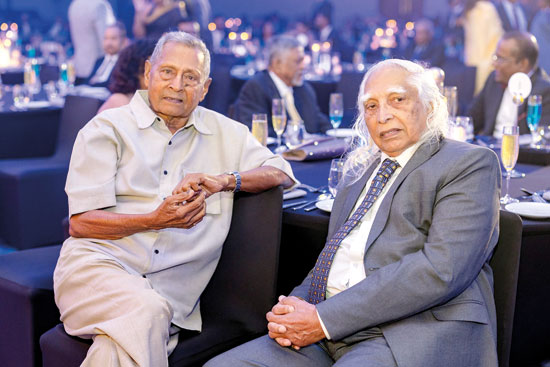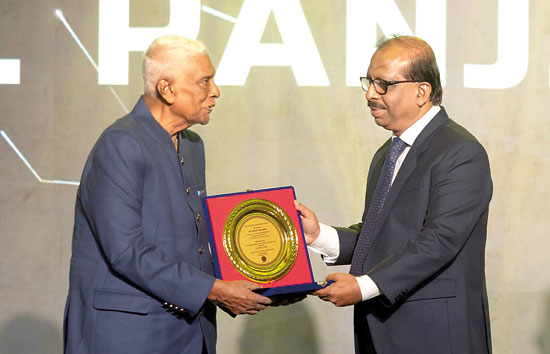When the brightest of them glittered in a sky full of stars
While Chamari Athapaththu, the women’s team captain, stole the limelight collecting six of the seven awards, including the women’s cricketer of the year award, and Kamindu Mendis was rightly rewarded for a stellar 2024 season across formats winning the cricketer of the year award, the evening’s most poignant moment was the recognition of three towering figures who helped shape Sri Lanka’s rich cricketing heritage.

(From left) Stanley Jayasinghe, Chandra Shaffter and Ranjit Fernando were honoured by SLC
Chandra Schaffter, the oldest living Sri Lankan cricketer, Stanley Jayasinghe, the first Sri Lankan to play county cricket, and Ranjit Fernando, who was Sri Lanka’s wicket-keeper batsman in their inaugural World Cup appearance, were honoured. Among those greats, Janaka Pathirana, a cricket administrator hailing from Kandy, was also honoured.
Born on April 3 of 1930, Chandra Thomas Adolphus Schaffter represents the living link to Ceylon’s cricketing past, making him an invaluable repository of the island’s cricket history. He played first class cricket for Ceylon in the 1950s and has witnessed the entire transformation of Sri Lankan cricket from its colonial origins to its current status as a major force in world cricket. His longevity and continued involvement in cricket affairs have made him a revered figure in the sport.
Beyond cricket, the former Thomian cricketer distinguished himself as a successful businessman, founding Sri Lanka’s first major Sri Lankan-owned life insurance company, Janashakthi, in 1994. His dual success in sports and business exemplifies the well-rounded nature of Sri Lankan cricket’s early pioneers. At 95, his presence at the awards ceremony represents the unbroken chain of Sri Lankan cricket
tradition.
Jayasinghe, a trailblazer who played county cricket for Leicestershire well before Sri Lanka earned Test status, was lauded for his path-breaking role. Born on January 19, 1931 in Badulla, the 94-year-old Jayasinghe stands as a testament to Sri Lankan cricket’s pioneering spirit. He was adjudged the Times of Ceylon Sportsman of the Year in 1951 and became a household name in cricket during the 1950s. Educated at Nalanda College, Colombo, where he captained the school team in 1951, Jayasinghe’s talent was evident from his schoolboy days.

What makes Jayasinghe’s contribution truly remarkable is his status as the first-ever cricketer from Sri Lanka (then Ceylon) to play for an English county club. He played county cricket with distinction for Leicestershire for five years and, prior to that, league cricket in Lancashire.
Beyond his sporting achievements, Jayasinghe demonstrated remarkable courage and principle. In 1965 he publicly refused to play against the whites-only South Africans who were touring England. This act of defiance against apartheid showcased his character both as a sportsman and as a human being.
Ranjit Fernando, a member of the 1975 World Cup squad, represents another crucial chapter in Sri Lankan cricket history. As part of the team that participated in the inaugural Cricket World Cup in England, Fernando was among the pioneers who put Sri Lankan cricket on the global stage. Fernando’s inclusion in that historic squad makes him part of an exclusive group of cricketers who helped establish Sri Lanka’s presence in world cricket, decades before the country would achieve its greatest triumph by winning the 1996 World Cup. All three served Sri Lanka Cricket across multiple roles, ranging from
selectors, coaches to team managers.
As Sri Lankan cricket continues to evolve and face new challenges, the recognition of these three veterans serves as both an acknowledgement of past achievements and an inspiration for future generations. Their stories of determination, breaking barriers, and representing their country with distinction remain as relevant today as they were decades ago, ensuring that their legacy will continue to inspire Sri Lankan cricketers for generations to come.


